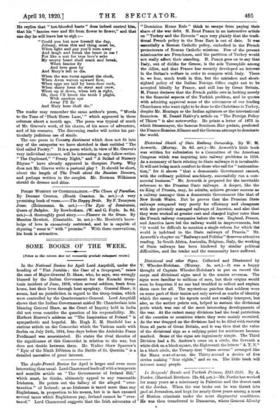Divisional and other Signs. Collected and Illustrated by V. Wheeler-Helohan.
(Murray. 5s. net )—It was a happy thought of Captain Wheeler-Holohan's to put on record the corps and divisional signs used in the armies overseas. The signs were familiar to millions of men, but their origins would soon be forgotten if no one had troubled to collect and explain them once for all. The mysterious patches that soldiers wore on some part of their tunics not only served as marks of identity which the enemy or his egents could not readily interpret, but also, as the author points out, helped to sustain the divisional pride which was one of the most interesting developments of the war. At the outset many divisions had the local patriotism of the counties or countries where they were mainly recruited. As the war dragged on the divisions had to be filled with rocruita from all parts of Great Britain, and it was then that the value of the divisional sign as a rallying-point for sentiment became marked. Some of the signs are ingeniously simple. The Third Division had a St. Andrew's cross on a circle, the Seventh a white disk on a black square, the Eighteenth the letters " A. T. N." in a black circle, the Twenty-first " three sevens " arranged like the Manx coat-of-arms, the Thirty-second a device of five circles making " four eights," and so on. The little book will interest many people.


































 Previous page
Previous page